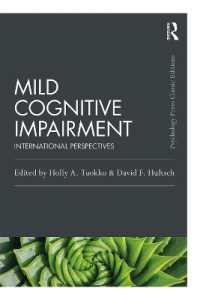- ホーム
- > 洋書
- > 英文書
- > History / World
基本説明
New in paperback. Hardcover was published in 2003. Focusing on the initial years of Japan's modern transformation, from the 1850s to the 1890s, Steele explores responses of commoners to the arrival of American warships in 1853; the growth of popular political consciousness; reactions of the residents of Edo in 1868 on the deposition of the shogun; responses of the village elite to the fall of the old regime; and established frameworks of historical narration - including American attempts to understand Japan's 1868 civil war.
Full Description
How did ordinary people experience Japan's modern transformation? What role did people in local areas play in the making of modern Japan? How do studies of local politics help explain national events?
The dominant account of modern Japanese history focuses on the nation-building that brought Japan into the modern world. After centuries of isolation, American warships forced Japan to open its doors to the West and a group of tough new leaders transformed the country into one of the great military and economic powers of the world. But different perspectives need to be examined. Alternative Narratives introduces other actors, other places and other dimensions of social and political activity in an attempt to construct a broader and more complex account of modern Japanese history.
Focusing on the initial years of Japan's modern transformation, from the 1850s to the 1890s, Steele explores responses of commoners to the arrival of American warships in 1853; the growth of popular political consciousness; reactions of the residents of Edo in 1868 on the deposition of the shogun; responses of the village elite to the fall of the old regime; and established frameworks of historical narration - including American attempts to understand Japan's 1868 civil war.
The author draws upon a wealth of documents, including broadsheets, woodblock prints, political cartoons and local campaign literature, as well as more conventional material in an endeavour to find new and different ways to examine the past. This book forms an important resource to students of Japanese history and culture while simultaneously appealing to scholars interested in the general problem of history and history-writing.
Contents
Acknowledgements; Illustrations; Introduction; 1 Goemon's New World View; 2 The Japanese Discovery of Japan; 3 The Village Elite in the Restoration Drama; 4 Everyday Politics in Restoration Period Japan; 5 Edo in 1868; 6 The United States and Japan's Civil War; 7 The Emperor's New Food; 8 Political Localism in Meiji Japan; 9 Peripheral Visions.








